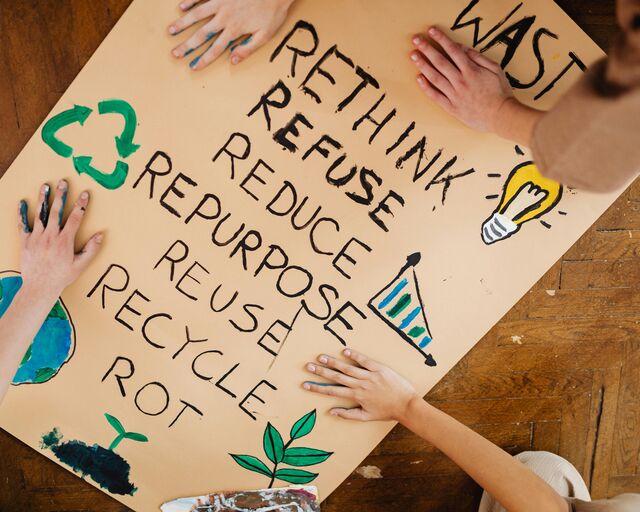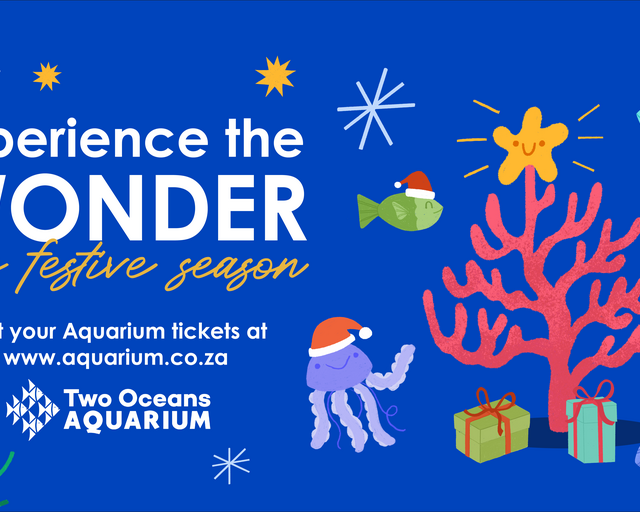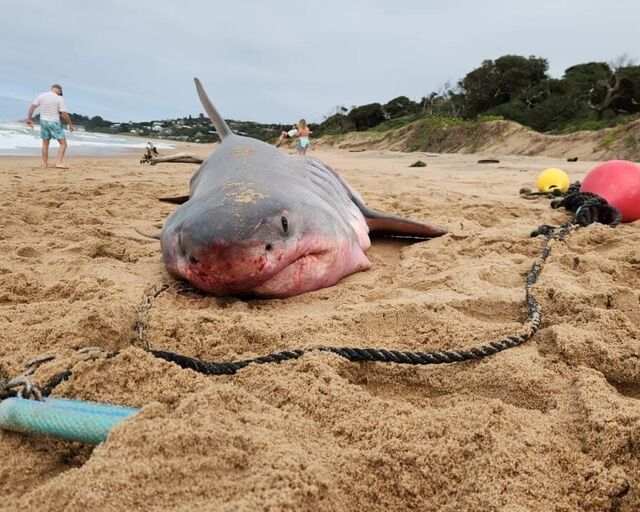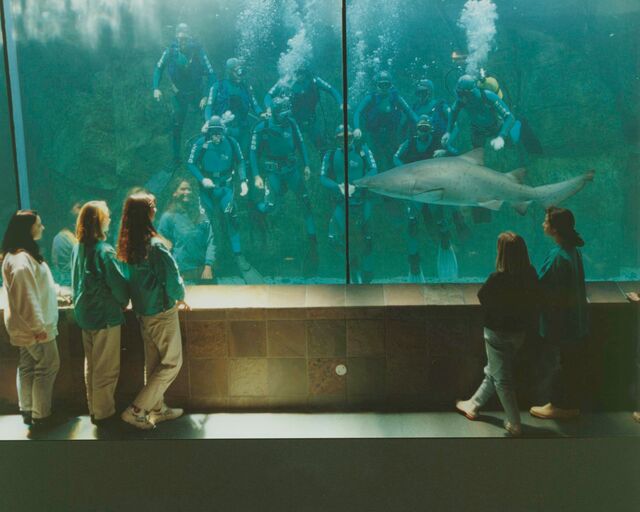The Two Oceans Aquarium is known for its incredible marine life. Perhaps the most awe-inspiring of our exhibits are the Save Our Seas Foundation Shark, Kelp Forest, and I&J Ocean Exhibits. Over 30 years, these stunning exhibits have inspired local and international visitors to take a deeper look at the world beneath the surface.
When the Aquarium opened on 13 November 1995, the then-Predator and Kelp Forest Exhibits were the main attractions that originally drew throngs of people to visit. Not only was the Kelp Forest Exhibit the first aboveground living kelp forest in the southern hemisphere, but seeing real sharks was an unmissable opportunity for many! Later, when the I&J Ocean Exhibit was built, its iconic “underwater” tunnel was a further incentive for visitors to return again and again.
Let’s take a swim down memory lane and look at the history of our three large-scale exhibits…
Predator exhibit
The predator exhibit (now the Save Our Seas Foundation Shark Exhibit) was the Two Oceans Aquarium’s first large-scale exhibit, beginning construction with the rest of the building.
Then-Director Lex Fearnhead had a clear vision for the predator exhibit – he wanted to showcase the incredible power and grace of tuna. Believe it or not, tuna rank amongst the top ocean predators. However, bringing that dream to life was no small task.

Duncan Temple-Forbes was brought on board as the Exhibit Designer to create the exhibit's underwater terrain, with the goal to fabricate something as natural as possible. The initial brief was that the rockwork could protrude no more than 30cm across a surface 15m long, 4m wide, and 6m deep! After countless revisions (and a few grey hairs), Duncan was finally given a little more freedom, with 50cm to perfect the design. Together with then-Curator, Patrick Garrett, he crafted a detailed plasticine scale model that was used to build the rockwork you see today. This painstaking process resulted in a jaw-dropping exhibit that visitors could enjoy from all angles, including a partial tunnel.

Just days before the Aquarium was set to open, word reached the team that a ragged-tooth shark had stranded in a Struisbaai tidal pool. Of course, a curious crowd had gathered, and the shark needed to be rescued. Aquarist Billy Stanley and a few other staff raced to the scene where they enacted a tense and unforgettable rescue.
The decision was made to give the shark a new temporary home in the predator exhibit, which was called the I&J Ocean Predator Exhibit at the time. The shark was dubbed Maxine, and she later became the first shark ever to be tagged and released back into the wild by the Aquarium. This moment cemented Maxine as an icon of conservation and the inspiration for the Save Our Seas Foundation M-Sea Programme, which used science and tracking data to educate and raise awareness for shark conservation.
Since these early days, the predator exhibit has temporarily housed many fascinating animals, including a rescued sunfish, which was released after a short recovery period! The Save Our Seas Foundation came on board as a sponsor in 2020, and the predator exhibit was given the name that many are familiar with today: The Save Our Seas Foundation Shark Exhibit.
Today, the exhibit is home to ragged-tooth sharks (who are tagged and released after a maximum of six years at the Aquarium), Cape yellowtails, yellowbelly rockcods, giant kobs, mullets, and strepies.
The ragged-tooth sharks, who quickly became the most famous inhabitants of the Save Our Seas Foundation Shark Exhibit, are ambassadors for their species. They play an educational and awareness role, giving people from all walks of life the chance to come face-to-face with these majestic animals and helping us to reverse the negative perceptions of sharks.
Kelp Forest Exhibit
The Kelp Forest Exhibit was our second large-scale exhibit – a feat of creativity, hard work, and many sleepless nights. It is now one of the most beloved exhibits at the Aquarium, but when the team set out to create it, they had no idea how much of an adventure it would be!
After Duncan Temple-Forbes and Patrick Garrett made such a success of the Predator Exhibit, Director Lex Fearnhead placed his full trust in the duo to bring a piece of the wild Cape coast to life. This would be the first aboveground living kelp forest in the southern hemisphere, so there was a lot of pressure to get it right!
From designing rockwork that would hide visitors from one another across the display to creating a perfect ocean-like surge for our kelp to thrive, every step tested the team’s creativity and perseverance.
Natural kelp forests depend on the wildness of the ocean surge – the strong wave action and southeasterly winds are integral to the process of upwelling, which brings cold, nutrient-rich water to the surface from the depths. These nutrients fertilise the kelp plants, allowing them to grow into giant forests, the canopies of which can be seen from the shore. To mimic the natural rhythm of the ocean, our engineers first built a scale model to calculate the stroke and timing of a custom-built plunger that would drive the surge in the exhibit.
Once the concept was proven, Duncan and Pat turned their attention to the rockwork. After some convincing of the authorities, they actually ventured into what is now Table Mountain National Park to take moulds of the rocks there. The team was truly committed to making the Kelp Forest Exhibit as close to the real thing as possible.
Soon after, the first rocks emerged from Duncan’s workshop, and once the intricate PVC lattice and acrylic panels were in place, the exhibit was ready for a hydro test. As the tank filled, it was a breathtaking sight. Until the plunger started to move, and the rocks began to float!
After some quick thinking, reattaching, and refilling so that the rocks would be heavy enough, the team brought in the fresh kelp, carefully tying it down to the rockwork. The exhibit looked perfect, but not without one last challenge: The silicone between the panels began to bulge! With the help of some American installers, the tank was drained once more and repaired. A week later, as the new silicone cured, the vision finally came to life.
After 30 years, the Kelp Forest Exhibit is one of our most popular – thousands of visitors find peace and tranquillity amongst the swaying fronds of kelp, where endemic fish and gully sharks glide and abalone, sea urchins, and rock lobsters take cover among the holdfasts. This iconic exhibit is more than just a glimpse into South Africa’s underwater forests; it’s the result of thoughtful collection, sustainable practices, and expert care. The Kelp Forest Exhibit stands as a living, breathing tribute to innovation, teamwork, and the magic of the ocean.

Ocean Exhibit
The I&J Ocean Exhibit has the most unique story out of our three largest exhibits!
Many years before the I&J Ocean Exhibit was envisioned, the team discovered that the Kelp Forest and the then-Predator Exhibits’ waterproofing systems were in serious need of major repairs. The Aquarium needed to temporarily close both exhibits to do the repairs, but what would our excited visitors say when the two biggest exhibits were not open?
A new exhibit was the perfect way to solve this problem! The public would get to marvel at an enormous, breathtaking new exhibit, and the animals in the Predator Exhibit would have a holiday home while the original two exhibits were closed for repairs.
Construction for the I&J Ocean Exhibit began in 2014 with great anticipation.
Not only would this stunning new exhibit be the Aquarium’s first major development in 20 years, but it would also be one of the most ambitious. The 10-metre-long tunnel is the first of its kind in Africa, allowing visitors to feel totally immersed in the ocean world!
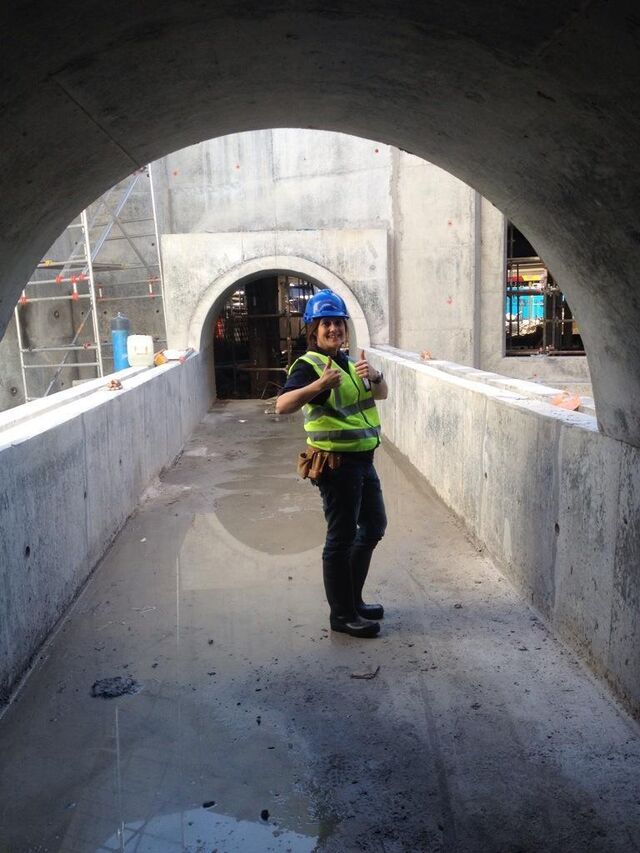
The exhibit would also be the perfect way to showcase the species that call the warmer waters of the Indian Ocean home. From the start, the I&J Ocean Exhibit was home to subtropical species such as rays, musselcrackers, indigenous fishes, and much more. The exhibit’s name honours the Aquarium’s long-standing partnership with I&J as leaders in responsible fishing practices and suppliers of sustainably sourced food for our animals.
After opening to the public in 2016, the exhibit quickly became one of our most loved. For 30 years, visitors have watched in awe as enormous rays float above their heads, and impressive musselcrackers swim past. The exhibit has also been the temporary home of many rescued turtles that underwent rehabilitation with the Turtle Conservation Centre.
Situated at the meeting point of the Indian and Atlantic Oceans, the Two Oceans Aquarium represents both. Our three largest exhibits, the Save Our Seas Foundation Shark Exhibit,Kelp Forest Exhibit, and I&J Ocean Exhibit, have epitomised the abundance and diversity of both oceans for three decades. Where else can you see such a beautiful celebration of marine life?
Related News
Sign up to our Newsletter
Receive monthly news, online courses and conservation programmes.

